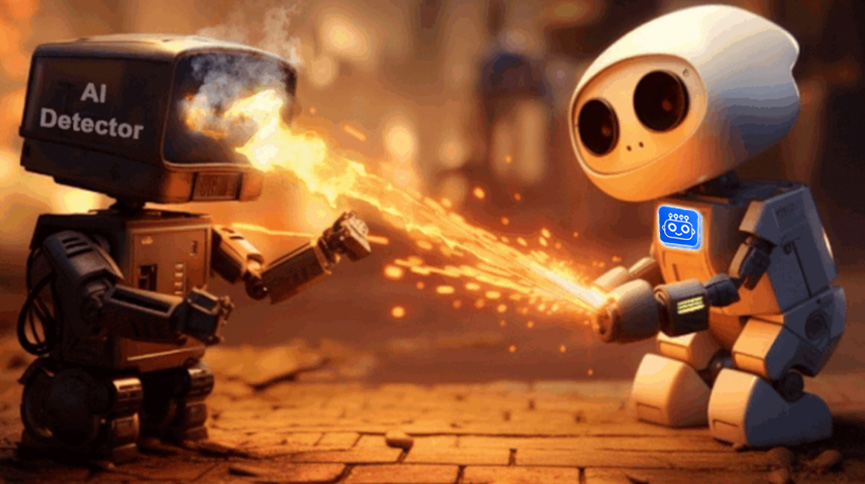In our ever-changing digital age, cracking the code on how to make AI writing undetectable has become all the rage.
AI has been on a roll lately. Whether it’s clever little chatbots taking care of your e-commerce needs or sophisticated writing tools cranking out killer content for blogs and essays, these bots are switching up how we generate content.

Try these new AI-powered tools:
- 5 Best AI Detectors To Unmask AI-Written Content With Accuracy
- 5 Best AI Writers To Boost Your Productivity And Content Quality.
- This "Secret AI Writer" Can Bypass AI Detection Like A Pro.
Get this, a recent forecast on the global market for AI writing assistant software predicts a whoppin’ market size of $1.022 billion by 2028.
That’s like going from a respectable $359.8 million in 2020 to hitting a steady 14.2% CAGR in less than a decade.
The credit for this surge? Well, that’s down to folks leaning heavily on AI assistance, especially in sectors like education, government, and content publishing.
But hold your horses, there’s a hitch. A ton of AI-crafted content is still getting sniffed out by those pesky AI writing detectors (most especially this one).
If you’re the type who does mostly copy-and-pasting from AI writing tools, then watch out! You’re skating on thin ice and could wind up in a world of pain with copyright infringement and plagiarism claims.
This piece is gonna serve up some slick tips on how to make your AI-generated content undetectable so it seems as though a legit human writer penned it. With the surge in AI writing tools, these tips will be as good as gold for writers.
Article At-A-Glance
-
- Most of the time, we can tell if a piece is AI-written. This could lead to issues like stolen content or cheating. That’s why we need ways to make AI writing fly under the radar.
- Having AI write in a manner that seems like it’s crafted by a genuine human can seriously boost a writer’s cool factor.
- Here’s the deal: AI has gotten so good it can pretty much write like a human. This opens up a ton of possibilities, but also some problems like accusations of copying, misunderstandings, and misconceptions.
- If we can make AI writing indistinguishable from human writing, that’s a game-changer. It’ll improve trust, readability, and how we use AI. But we’ll need tricks like changing writing styles, throwing in some human-written parts, and solid editing and proofreading to pull it off.
Table Of Contents
- 1 Why It’s Essential To Make AI Writing Undetectable
- 2 7 Stealthy Tips On How To Make AI Writing Undetectable
- 2.1 7. Mix Up Writing Styles And Voices
- 2.2 6. Sprinkle In Some Human-Written Content
- 2.3 5. Tweak The Sentence Structure
- 2.4 4. Get Inspiration From Various Sources
- 2.5 3. Play Around With Synonyms And Alternative Phrases
- 2.6 2. Add Personal Touches And Quirks
- 2.7 1. Get Your Editing And Proofreading Game On
- 3 The Inside Scoop On How AI Writing Detection Works
- 4 Advancements And Pitfalls Of AI Writing
- 5 Making AI Writing Undetectable Is No Easy Task
Why It’s Essential To Make AI Writing Undetectable
Making AI writing undetectable hits the bull’s eye because when people can’t figure out if a piece of writing was cooked up by AI or written by a human, it helps keep trust and authenticity intact.
Getting AI to write in a way that looks like it’s been penned by a real person can pump up a writer’s street cred.
- Better Readability. The power of AI tech to dish out writing that can’t be told apart from human-authored pieces carries a bunch of perks by making written content more user-friendly. When spitting out readable text through machine learning models with natural language generation capabilities, the AI software should aim for a clear, error-free, and natural flow so readers can engage and understand with ease.
- Enhanced Engagement. Text dished out by AI that does a bang-up job of imitating human writing can be a real crowd-pleaser. A smooth storytelling style can grab their attention and crank up their satisfaction with the material served up.
- Wider Range of Use. When an AI can whip up human-like text, it opens up a whole new world of opportunities that span across various domains. Top-notch content creation, seamless customer service, and tailor-made assistant functions are just a few examples of the huge impact an AI could have when it’s firing on all cylinders.
Getting AI to write in a way that looks like it’s been penned by a real person can pump up a writer’s street cred.
However, keeping it real about AI’s involvement is also super important to avoid pulling the wool over readers’ eyes. Plus, it can help the writer keep their integrity in check.
7 Stealthy Tips On How To Make AI Writing Undetectable
AI content can be pretty much undetectable. By pulling out all the stops with a range of strategies discussed below, we can make AI writing go under the radar.
Here are some slick tricks for making AI writing undetectable.
7. Mix Up Writing Styles And Voices
Flipping between different writing styles and voices can be a solid way of making AI-penned content undetectable. You can play around with different writing styles like narrative, persuasive, conversational, and expository to make the AI-generated content one-of-a-kind in both structure and tone.
Using different voices, like passive and active, lets us whip up content that’s tailored for various audiences while still hitting the mark on readability.
To nail these techniques, some writers and organizations turn to this undetectable AI writing tool – a tool designed to rephrase AI-generated text into human-like language without missing a beat.
6. Sprinkle In Some Human-Written Content
Weaving in some human-written content into AI-spun writing can be a real game-changer to keep our content from being flagged up.
Getting some human touch involved is the first stepping stone towards making detection tools do their job properly, letting us cook up unique and authentic content that adds flavor to what’s already there.
This basically means we don’t just take whatever the AI writing tool spits out and copy-paste it.
This means we don’t just take whatever the AI writing tool spits out and copy-paste it.
By blending both AI and human writing, we can crank up readability and coherence while keeping things efficient.
5. Tweak The Sentence Structure
When making AI-created writing undetectable, it’s crucial to keep a close eye on the backbone of sentences – the sentence structure.
Sentence structure is a big player in both readability and coherence, which means we gotta steer clear of long and complex sentences. In other words, keep things neat and simple.
A nifty way to tweak sentence structure without ditching efficiency or authenticity is by breaking down chunky ideas into smaller bites or parts with snappy phrases.
This makes things a whole lot easier for our readers as they won’t be scratching their heads trying to figure out what’s being said.
Plus, simple sentence structures can slip under the radar of most AI detectors since overly twisty sentence patterns are usually a dead giveaway for bot-written content
4. Get Inspiration From Various Sources
Adding a variety of sources into the AI writing mix is a great way to keep your content under the detection radar.
By pulling in information from news articles, podcasts, social media posts, and blogs, you can ensure there’s a good mix in the content cooked up by the AI system.
Using a medley of different sources gives your content depth, complexity, and authenticity. Plus, it also ensures higher-quality output that’s less likely to be sniffed out by detection tools as machine-written.
3. Play Around With Synonyms And Alternative Phrases
Pulling out all the stops with synonyms and alternative phrases is also a solid trick to make AI writing undetectable. For instance, using synonyms can keep us from sounding like a broken record with the same words and phrases.
They let us dish out more natural-sounding content that’s less likely to set off detection alarms designed to tell apart AI-generated content from human-penned pieces.
Words like “very” or “nice” can be swapped out for fancier expressions such as “sublime” or “proficient.” This whips up a better quality of text with its own unique style that won’t smack of written by an AI bot.
Words like “very” or “nice” can be swapped out for fancier expressions such as “sublime” or “proficient.” This whips up a better quality of text with its own unique style that won’t smack of being written by an AI bot.
An article about cats could use alternative words for ‘cat’ such as feline, kitty, furball, etc., rather than just using ‘cat’ on repeat.
Plus, context is also important when using synonyms – making sure they fit in both grammatically and syntactically so as not to disrupt the reading flow of readers who can spot a blooper from a mile off, even if detection algorithms drop the ball.
2. Add Personal Touches And Quirks
You gotta paint your content with some unique strokes of personality. Think of it like seasoning your favorite dish—it needs a bit of salt here, a pinch of pepper there, and a spoonful of spices to bring out the flavor.
Try dropping in some personal tales, stir in metaphors or stories, spin a narrative arc, or even toss in a joke or two where it fits.
The right blend of these elements can be the secret sauce that makes your content a tasty read for your audience, hooking them emotionally. Plus, it gives the impression that your content is scribbled by a genuine person and not some cold, impersonal AI.
Creating this type of bond with your readers can help establish a level of trust and camaraderie, strengthening your connection with them.
1. Get Your Editing And Proofreading Game On
Just like the chef’s holy trinity of onions, carrots, and celery, grammar, spelling, and punctuation are your three musketeers in whipping up content that feels human-written.
For instance, smoothing over usual bumps like awkward wording or bungled words can quickly shift your AI-written content from sounding like a machine to something that feels real and natural.
Also, remember that fact-checking is as crucial as your morning coffee. It’s the ticket to ensuring you’re not leading your readers down a winding path of false information.
And let’s not forget about the flow! Making sure your text flows as seamlessly as a symphony between sentences and paragraphs is the golden ticket. It’s what lets your readers glide through your content without a hitch.
After all, the aim is to make sure your readers aren’t left scratching their heads, trying to decode mind-boggling sentences or puzzling concepts.
I know that’s a lot of best practices to keep in mind when making AI-generated content undetectable. However, cloaking AI-written text can be a no-sweat process if you have the right tool.
This particular undetectable AI writing tool can help you give detectors a curve ball by rewording machine-generated content into language that reads almost exactly like human language.
This tool is a real gem for writers looking to churn out undetectable content that’s primed for search engines as well as blogs and research projects.
This tool is a real gem for writers looking to churn out undetectable content that’s primed for search engines as well as blogs and research projects.
The Inside Scoop On How AI Writing Detection Works
When we talk about understanding AI writing detection, we’re discussing how a computer program or system can spot and scrutinize text that’s been whipped up by an AI writer.
Why does this matter? Well, it helps us nail down if a piece of writing was penned by a human or churned out by an AI program.
To zero in on AI-generated content, automated systems whip out a mix of language processing and machine learning algorithms. This way they can spot the tell-tale signs and styles that scream “written by a bot!”
To zero in on AI-generated content, automated systems whip out a mix of language processing and machine learning algorithms. This way they can spot the tell-tale signs and styles that scream “written by a bot!”
At its heart, AI tech is employed to whip up writing. And for wordsmiths like us, that’s a handy tool to have.
AI-generated writing is crafted using algorithms that digest data and crank out content in a way that mirrors human thought or composition. Spotting such machine-generated texts can be tricky as it isn’t always clear-cut which copy is the handiwork of an AI system versus what’s been inked by a person.
Lucky for us, there have been leaps and bounds in the realm of natural language processing (NLP), making for pinpoint detection.
-
- NLP leverages computational models to spot meaning in text, peering at features like word choice, syntax structure, and sentiment analysis, ultimately recognizing patterns between them.
- NLP tech helps sniff out machine-written content, taking note of simple stuff like sentence length and how punctuation marks are used.
- By keeping tabs on these basic elements, it can offer up more accurate results compared to the old-school methods that only had eyes for keywords.
- NLP also compiles a cache of statistical regularities to calculate probability scores for chunks or words being identified as either spat out by a machine or penned by a human writer. This is usually referred to as “entropy score” modeling.
Advancements And Pitfalls Of AI Writing
AI writing has come a long way in dishing out human-like text, making it handy in a bunch of applications like content creation and customer support.
It brings some hefty capabilities to the table, like the ability to crank out tons of human-like content in a snap. But this power also comes with potential pitfalls like plagiarism and manipulation.
Striking a balance between the benefits and risks of AI writing is key to harnessing its potential while keeping any nasty societal impacts at bay.
The Power To Generate Human-Like Content
AI writing has come leaps and bounds in recent years, thanks to a blend of NLP algorithms and machine learning tech.
With AI methods like natural language generation (NLG) or latent semantic analysis (LSA), machines can get a handle on user intent and crank out near-human quality sentences in a fraction of the time it’d take a person using traditional methods.
By learning from vast data, AI models can get the hang of patterns, styles, and structures often used in human writing.
The ability of AI to generate human-like content means that a computer program or system can whip up text that’s almost indistinguishable from what a human would write.
By learning from vast data, AI models can get the hang of patterns, styles, and structures often used in human writing.
This lets them churn out sentences, paragraphs, or even entire articles that sound like they’ve been penned by a person.
The Potential Snags Of AI Writing
AI-created content can be a whopper of a tool for businesses, organizations, and even individuals. But let’s not forget, it does come with a bag of risks since computer algorithms often don’t have the same human touch as folks who genuinely pen their thoughts.
This can make it tough to build a real connection through writing when it’s all cooked up by computers – pumping up the danger of miscommunication, misinterpretation, or errors.
Plus, leaning too heavily on AI for writing could end up in a sticky situation with plagiarism and the risk of your unique brand voice going AWOL. As writers, we gotta tread carefully and use a range of techniques, like tossing in different words and phrases to keep the authenticity game strong.
Companies splurging on AI-driven content also need to keep their eyes peeled when putting their trust in automated systems. There’s always the risk of running into a wall with problems like spreading false info or coming across as biased, which could put a dent in the company’s reputation.
Companies gotta make sure they keep their unique voice loud and clear and stay upfront to maintain trust and stop their brand from losing its identity.
Making AI Writing Undetectable Is No Easy Task
Ensuring your content is as easy to read as a child’s storybook and flows like a catchy tune is absolutely critical. You can polish up readability by tweaking the tone of voice until it rings both natural and harmonizes with your audience.
Also, constructing sentences that don’t blare out “AI” is a nifty way to make AI writing fly under the radar.
Don’t forget to keep your audience at the heart of it all. Your readers are hankering for content that’s not just relevant but also resonates with them on a deeper level. So, scrap the generic, fits-all-sizes articles—they’ve had their day!
Invest some time in really getting under the skin of your audience. You’ll find this approach can yield some genuinely out-of-the-box ideas that nail it every time.
When it comes to harnessing AI-writing tech, you’ve got to find the happy medium between productivity and authenticity. So, don’t just kick back and let automation do all the heavy lifting.
When it comes to harnessing AI-writing tech, you’ve got to find the happy medium between productivity and authenticity. So, don’t just kick back and let automation do all the heavy lifting.
You’ve still got to toss in a little bit of human touch to stir things up.
By sticking to these tried-and-true tactics, you’re ensuring you’re optimizing your potential when using cutting-edge AI writing tools.
But let’s not kid ourselves—it’s a tough gig. Crafting content that not only stays off the AI radar but also dishes up valuable and captivating material for the reader takes some serious skill and elbow grease.
But hey, it’s worth the sweat, fusing AI’s horsepower with the unique human flair.
Remember, no matter how high-tech and futuristic our AI writing tech gets, we’ve got to keep it all in English, as clear and plain as a sunny day.
Meet our resident tech wizard, Steve the AI Guy. Now, before you get any wild ideas, let’s clear up one thing – he’s 100% human! I mean, he’s got the work history to prove it. He spent a decade diving into the deep end of the tech industry doing business intelligence work, splashing around with two of the world’s largest business consulting companies, Deloitte and Ernst & Young. Learn More










